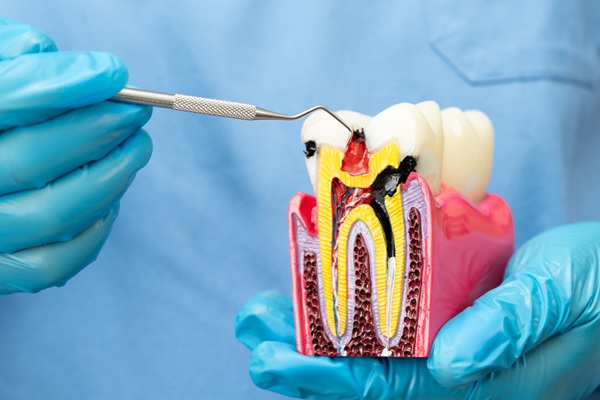Root Canal Therapy for a Tooth Infection

Root canal therapy, also known as endodontic therapy, is one of the most common dental procedures performed, but it’s certainly not one of the most enjoyable. It’s unpleasant to think about having an infected tooth removed and some of your jawbone along with it. To make things worse, it can be difficult to know if you need endodontic therapy or if you need regular dental care. But there are ways to tell when endodontic therapy might be in your future.
What are root canals?
A root canal is a dental treatment performed to relieve tooth pain when tooth decay or damage has occurred. During endodontic therapy, the infected pulp is removed from the inside of a tooth and sealed with filling materials. A crown, if needed, may then be placed over your natural tooth to protect it and allow you to chew normally again. It’s important to understand that even though endodontic therapy is typically not painful, they are necessary to remove an infection from your teeth and restore them to health again.
It’s important to understand that while endodontic therapy doesn’t cause any pain, they are necessary to restore your natural teeth. The alternative to a canal is usually tooth extraction. When there is no longer anything keeping an infected tooth from crumbling apart, removing it becomes necessary. However, once extracted, a tooth can never grow back—so always do your research before deciding which option might be best for you.
When do you need endodontic therapy?
When your tooth is infected or inflamed (usually due to decay or trauma) and requires treatment beyond an uncomplicated filling, your dentist may recommend endodontic therapy. In addition to addressing any infection in and around your teeth, endodontic therapy can save a tooth that would otherwise be pulled out. With good oral hygiene, endodontic therapy is both cost-effective and long-lasting.
What happens during endodontic therapy?
You’ll get some local anesthetic to numb your tooth. A small hole will be drilled into your tooth, and then tiny instruments are used to remove the infected material and clean out your root. This process typically takes 1–2 hours. Afterward, you’ll need to fill in any remaining space with a final filling or crown (depending on how much damage was done).
In rare cases, you may need an implant to replace your tooth permanently. Because endodontic therapy can help save your natural teeth, it’s generally recommended over extractions in all but the most severe cases.
Endodontic therapy involves eliminating infection, cleaning out surrounding dead and diseased tissue, then sealing and filling your tooth. Each step is necessary to ensure that your tooth isn’t reinfected, causing serious problems down the road. The process can be done in just one visit or may require more than one round of treatment depending on how infected or damaged your tooth is.
After the treatment, what happens next?
The dentist will have you rinse your mouth with mouthwash and suggest that you take an antibiotic, along with ibuprofen or acetaminophen, to ease the pain. Over-the-counter pain relievers can work fine for mild discomfort but don’t wait to reach for these if your pain is moderate or worse. You’ll also want to avoid eating anything that might break or bruise your treated tooth. Stick to soft food and cold drinks until your mouth has healed.
Speak with your dentist
Tooth infections can be incredibly painful and dangerous. It is important to get professional dental care immediately. If you suspect that you may have an infected tooth, call today to schedule your appointment.
Request an appointment here: https://www.kevinjdailydds.com or call Kevin J Daily DDS at (831) 580-1141 for an appointment in our Santa Cruz office.
Check out what others are saying about our dental services on Yelp: Root Canal Treatment in Santa Cruz, CA.
Recent Posts
A root canal restores a damaged or infected tooth without removing it, and recovery usually proceeds smoothly with the right care. Mild tenderness is common as the tissues calm down, especially when chewing or when the tooth is touched. Good oral hygiene, smart food choices, and timely follow-up help the tooth feel normal again. Because…
Finding out that you need a root canal can be nerve-racking. Caring for the treated tooth can be even more stressful. Knowing what to do after the treatment can help you prepare well for it. Here are some tips for a smooth and quick recovery after your root canal.The patient must wait to eat as…
A root canal treatment can restore your tooth. It is an invasive treatment that aims to remove the damaged or infected pulp. But what should you do after this outpatient procedure? Here are the details on what will happen after a root canal.The dentist will suggest waiting until the effects of the anesthesia fade before…
Root canal treatment is typically recommended as a last resort to save a severely damaged, infected, or decayed tooth. It is often a necessity when a tooth has a damaged pulp. The pulp refers to the soft tissues inside a tooth, which are stored in the pulp chamber, the innermost layer of a tooth.When a…


